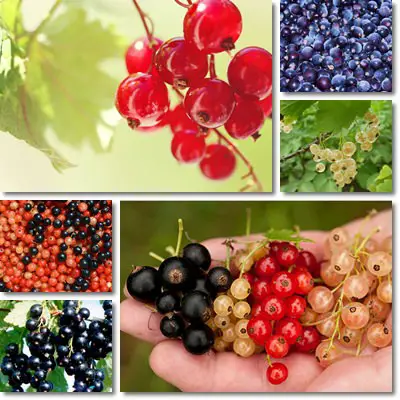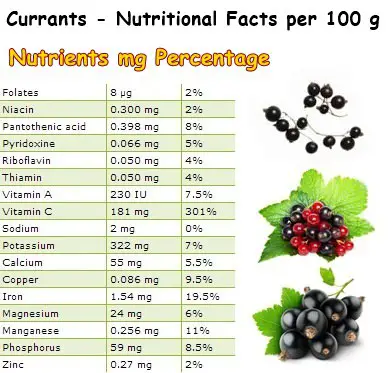Today I am going to tell you about a beautiful, nutritious and delicious berry: currants. Like all berries, currants (Ribes) boast a high antioxidant content and are generally a great source of vitamins and dietary minerals.
More important, they boast great antioxidant value thanks to their excellent anthocyanin and other flavonoids content. Blackcurrants stand out as the richest source of anthocyanin antioxidants out of the three varieties, as indicates their dark blue color.
Although they may differ in color and antioxidant content, all three currant varieties (black, red and white) are equally nutritious. Studies associate regular consumption of both red and black currants with lower inflammation levels, good overall cognitive health and, not surprisingly, a lower incidence of cancer. If you have a patch of garden and wouldn’t mind a fresh production of beautiful-looking sweet and tart berries of your own, you can always plant a currant.

What do currants look like?
The currant plant looks very much like a meager forest bush with yellow-green, maple-like leaves and tiny, perfectly round fruits that tend to grow separately (not in bunches, I mean). You can find them in the wild or just as easily grow them in your back yard. Botanically speaking, there are two main currant species: blackcurrant and redcurrant. White currant is actually the albino version of redcurrant, meaning it is missing some (antioxidant) pigments. Currants with pink and yellow skin exist as well, but they are merely hybrids.
Currant varieties:
- Blackcurrant (Ribes nigrum) is native to Northern Europe.
- Redcurrant (Ribes rubrum) is native to Western Europe.
- Redcurrant cultivars include: white currant (Ribes petraeum), pink currant (Ribes vulgare) and golden currant (Ribes aureum), which goes from orange to black when ripe.
- Greencurrant, or green currant, is a sweeter, green pigmented variety of blackcurrant.
What do currants taste like?
What do blackcurrant, redcurrant and white currant berries look and taste like? Blackcurrant berries have opaque, glossy skin of a purple-black color and a tart, somewhat sweet taste. Redcurrants are a bit more acidic than black ones, yet somewhat sweet. Ripe berries are beautiful-looking, with a transparent, bright red, finely ribbed skin that appears transparent, letting the inside of the fruit be visible. White currant berries are considerably sweeter and less tart than their red counterparts.
This is because of their lack of pigment which indicates the lack of anthocyanins, antioxidants which also give the fruit a slightly astringent taste. Although currants are extremely popular in pies, pastry, jams, cakes and so on, my advice is to enjoy them fresh from time to time and get some vitamin C in your system. Vitamin C is particularly sensitive to cooking heat and only 15-20 minutes of cooking can destroy the nutrient completely.

Currants uses and benefits
Find out below what are the health benefits of blackcurrant, redcurrant and white currant berries:
Anti-inflammatory, antimicrobial and anti-aging properties
Blackcurrant berries have the highest vitamin C content (181 mg/100 g), followed by red and white currant berries (41 mg). Vitamin C is a potent natural anti-inflammatory, antioxidant and antimicrobial and a generous dietary intake is essential for good physical health. For instance, vitamin C boosts immunity, promotes faster recovery after illness, efficiently reduces inflammation levels in the body and, of course, stimulates collagen production and thus contributes to maintaining a youthful, firm, wrinkle-free skin, bone and tissue health.
Good for cardiovascular health
The good amounts of vitamin C in currants stimulate the production of collagen, the principal structural protein in our body that ensures (skin, organs and) blood vessel integrity. Moreover, studies suggest that vitamin C-rich foods such as (black)currants help clear blood vessels of cholesterol and acts as a local antioxidant, contributing immensely to cardiovascular health. The moderate amounts of magnesium (6%) and potassium (7%) ensure the good functioning of the heart muscle and regulate blood pressure, two key elements in the prevention of heart disease.

Wonderful antioxidant content
In addition to vitamin and mineral antioxidants such as copper, manganese, vitamins A and C, currants are rich in anthocyanins, potent pigmented flavonoids with outstanding antioxidant activity. Flavonoids are responsible for the bright red and purple-black colors of currants and other berries, fruits and vegetables. According to research, flavonoid antioxidants in red and especially black currants not only scavenge free radicals, but also reduce inflammation, known to be a precursor of most chronic illnesses, especially diabetes, cardiovascular disease and cancer. The fruit richest in antioxidant flavonoid anthocyanins is the chokeberry or aronia
– see benefits of aronia berries.
Excellent tonic properties
Black and red currant juice makes an excellent tonic due to the fact that it concentrates great amounts of vitamins and minerals such as vitamin A, B vitamins, calcium, copper (9.5%), iron (19.5%), magnesium, manganese (11%), phosphorus (8.5%) and zinc.
Currants as natural remedies
Preparations from currants, berries and plant parts, are used as natural remedies for diarrhea, sore throat, fever and other respiratory and gastrointestinal problems. Traditionally, currant leaves, dried fruit and flowers were infused and used to reduce fever by inducing perspiration (sweating), calm throat irritation, cough, detoxify the kidneys (diuretic) and help treat diarrhea (as a result of their astringent components).
Conclusion
All in all, currants are an amazing source of antioxidants which not only protect us from chronic illnesses, but also keep us in good physical health, energized and refreshed. They are more than 80% water and contain good amounts of dietary fiber (around 4.3 g of fiber/100 g of berries) and thus help us stay hydrated and promote digestive health. As a bonus, redcurrants look amazing as cake decorations, in a fruit bowl or a summer salad. What more could one ask for?
